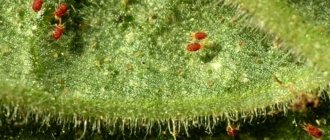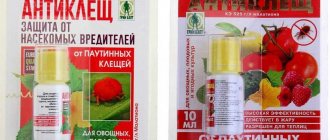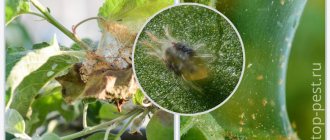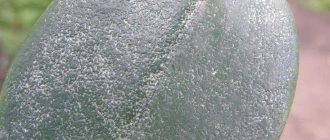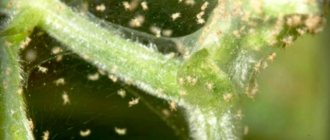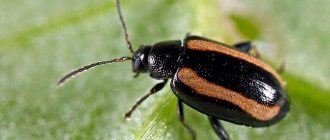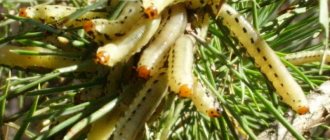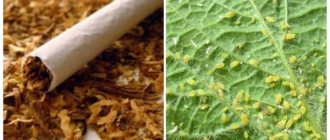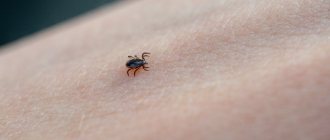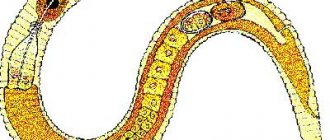If you notice that the foliage on the strawberry bushes has begun to curl into tubes, and attempts to completely unfold them are unsuccessful, then this indicates that it is time to think about how to deal with the strawberry mite on strawberries. Usually, when beds are infested with this pest, the crop continues to develop successfully and even produces quite good first berries. However, after some time, growth and development slow down, the foliage curls up, turns yellow and falls off, and the berries dry out right on the peduncles.
Mite on strawberry with photo
Garden strawberries are affected mainly by 2 types of mites: strawberry mites (Phytonemus pallidus), sometimes called cyclamen mites by florists, and the common spider mite (Tetranychus urticae). Fighting the latter is not much of a problem. Both specific acaricides and insectoacaricides from the organophosphorus group cope with it. The fight against strawberry is more complex, so the recommendations presented in the article are focused specifically on this type of pest.
The strawberry mite (Phytonemus pallidus) has a flattened, elongated, translucent body. Adults reach a length of about 230 microns. Due to its small size, this arthropod can only be seen through a microscope or a magnifying glass with 10x magnification.
Ticks have enormous fertility with a short period of larval growth. In one strawberry season, about five generations can appear in the beds. The peak of damage occurs at the end of summer. When the temperature drops to +10℃, the tick hides in leaf folds for the winter. Threshold of tangible economic damage from mites: 4-8 mites per leaf.
The tick feeds on plant sap and lives in the central bud—the heart. The youngest unblown leaves are affected.
Among modern varieties, Elsanta strawberry showed excellent resistance to mites
How to recognize a strawberry pest?
Gardeners may be upset by the fact that it is impossible to see the strawberry mite with the naked eye. Actually, even a magnifying glass is unlikely to help if it does not have 8x magnification:
- the length of adult individuals does not exceed 0.24 mm;
- body almost transparent, oval;
- The color of ticks varies from pale greenish to yellowish shades.
The colony of mites prefers to be localized on the underside of the leaf, choosing young and juicy greens. These insects feed on the juices of the plant, depriving it of the nutrients necessary for growth, ovary and fruiting. Pests often attack newly formed rosettes of leaves, preventing their further development.
If it is impossible to see mites on strawberries, how can you understand that the berry bush has suffered from their activity? This can be done based on obvious signs of damage:
- the growth of specimens slowed down and later stopped altogether;
- young foliage has become wavy or wrinkled;
- leaves begin to turn yellow and dry out earlier than expected;
- the back side of the leaf plates is covered with a silvery coating;
- the berries do not ripen and dry out;
- bushes lose frost resistance and die in winter.
With such alarming signs, the berry planting requires mandatory treatment. And the owner will have to work hard, since fighting the strawberry mite on strawberries is not an easy task.
How to deal with strawberry and spider mites
There are several methods for removing mites from cultivated plants:
- The use of special chemicals.
- Using folk recipes.
- Biological agents.
Unfortunately, there is not yet a single method that can rid plants of strawberry mites 100%. Experts advise using several techniques simultaneously, not forgetting about timely preventive measures. You can get rid of ticks only with the help of complex therapy.
Chemicals
The most radical method is considered to be the fight against mites on strawberries using special preparations for this insect. There are a large number of chemical acaricides, the action of which is aimed at destroying pests.
Karbofos
A popular acaricide in gardening, it is moderately toxic. Insects and arachnids of many species are susceptible to it. A solution is prepared based on Karbofos according to the recommendations specified in the instructions. Then the product is used, strictly adhering to certain rules:
- strawberry or strawberry bushes are sprayed with freshly prepared product;
- the composition must be applied to both sides of the sheet;
- It is better to choose a dry, windless day for the procedure. The most suitable time is morning or evening;
- During the season, it is enough to carry out the procedure twice.
During the flowering period, berry bushes cannot be treated with insecticidal preparations against ticks!
Colloidal sulfur
This is an effective pesticide in the form of a suspension that acts on various types of insects, including weevils and strawberry mites. To process strawberries, a powder or paste with a 70% concentration is prepared.
During the procedure, it is important to adhere to the temperature regime:
- The optimal air temperature for the greatest effectiveness of the drug is +20 – + 30 degrees.
- In cooler weather, the effect of colloidal sulfur is reduced.
- In hot weather, treatment can result in plant burns.
This product has low toxicity for people and animals, but is dangerous for bees and other insects.
Neoron
Another effective acaricidal drug that helps fight strawberry mites. Neoron is available in ampoules and is slightly toxic to beneficial insects.
It is prohibited to mix this product with other chemicals.
Morolex
This product from a Polish manufacturer allows you to cure plants from strawberry mites, however, you must adhere to certain rules:
- for processing strawberries, a solution is prepared at the rate of 10 ml of the drug per liter of water;
- Marolex does not act on mite eggs, so 4 procedures with a 3-day interval will be required.
Thiovit
The active ingredient of this acaricidal drug is high-quality sulfur.
Thiovit is available in the form of large granules, highly soluble in water.
The advantage of the product is safety for humans, animals and beneficial insects. You can harvest the crop within a day after processing the bushes.
Fitoverm
This is an insectoacaricidal biological product of the latest generation, effective against most pests of garden and indoor vegetation.
To remove strawberry mites from strawberries, 2-3 treatments with Fitoverm will be required at 3-7 day intervals. D
The effect of the drug decreases against the background of light precipitation, heavy dew, and lower air temperatures.
Fufaphone
To remove parasites, it is necessary to prepare a medicinal solution from the drug - 30 ml of the product per 10 liters of water. It is recommended to treat bushes once a week; 3 procedures will be required.
Since the strawberry mite quickly develops resistance to chemicals, it is better to alternate medications with different active ingredients.
Other drugs
In the variety of chemical means for destroying strawberry mites, in addition to the substances described above, the following drugs can be distinguished:
- Actellik - this drug is developed on the basis of the active substance pirimifosmethyl. Acaricide is a pesticide with enteric contact action. A distinctive feature is that the effect is enhanced at high humidity and outdoor temperatures from +15 0C to +25 0C;
- Kemifos - in addition to contact and intestinal, it also has a fumigating effect, because The main active ingredient is malathion. Kemifos is considered an early spring insecticide, applied before the ovaries appear;
It should be remembered that ticks develop an addiction to many drugs individually, as a result of which their effectiveness decreases and the risk of crop loss increases. To avoid this, it is necessary to alternate the use of different drugs and practice complex treatment.
Strawberry plantings must be treated with chemicals at least 3-5 times per season until the pest is completely destroyed.
When spraying with any chemicals, it is important to follow the following rules:
- should be processed in dry, windless weather to avoid contact with neighboring crops;
- When working, follow safety rules and use personal protective equipment: goggles, protective mask or respirator, rubber gloves;
- the operating time must be chosen: in the morning before 9 o’clock, when the dew has already disappeared, or in the evening after 18 o’clock;
- the air temperature should not be lower than +18 0C;
- Spray the leaf thoroughly on each side.
Folk remedies
In the fight against pests, do not underestimate the effectiveness of proven traditional methods.
Hot water for ticks
If there is a suspicion that strawberry seedlings are affected by the strawberry mite, then you can hold them for 12-15 minutes in hot water (+46-+48 degrees), completely immersing them in it.
The most difficult thing is to maintain the temperature throughout the entire procedure. After this, the plants should be cooled and placed in a container with cold water (+10 - +15 degrees). This is necessary to eliminate heat shock.
A hot bath for bushes can be given throughout the summer, but no later than mid-August. In this case, strong seedlings with a developed growth bud, rhizome and 3-5 leaves with short thick petioles will leave before winter.
In the beds in the spring, when the “hearts” grow, strawberry or strawberry bushes can also be shed with hot water heated to +55 - +60 degrees. 500 ml of water per plant is enough.
Onion peel tincture
In the spring, with the appearance of the first leaves, when the plants form buds, you can save them from mites and weevils using onion peel tincture. It is recommended to use the same product twice after picking berries. It is prepared according to the following recipe:
- 0.2 kg of raw materials is poured into a bucket of water;
- the composition is infused for 4-5 days;
- then it should be filtered and the resulting solution should be sprayed onto the plantings.
Decoction of tomato leaves
Also in spring, berry bushes are sprayed with a decoction made from tomato tops. To prepare it:
- 800-1000 g of dried raw materials should be poured with a bucket of warm water.
- Leave the mixture to infuse for 3-4 hours.
- Afterwards, the infusion should be boiled for 2-3 hours and strained.
- The concentration of the solution must be reduced by diluting it with water in a ratio of 1:2.
- Add 40 g of laundry soap shavings to it.
- Treatment consists of spraying mite-affected specimens.
Garlic broth
Many gardeners prefer to use this natural medicine to remove strawberry mites from Victoria strawberry bushes and other berry crops. To prepare garlic extract, you need:
- Grind 200 g of garlic cloves.
- Fill them with 10 liters of water.
- Stir the mixture and strain.
- This folk remedy should be used immediately after preparation, spraying insect-infested vegetation.
Mechanical methods of struggle
It is impossible to collect parasites manually: they are too small. It is recommended to pull out and burn drying bushes, but this method will not help get rid of insects.
Related article:
How to transplant strawberries to a new place in the spring so that they bear fruit
If the old plants cannot be saved, you can try to disinfect the young rosettes and transplant them to a new location. To do this, the water is heated to 48 degrees. The bushes are placed in a basket or bucket with holes, pressed down with a small weight on top so that they do not float up.
The sockets are placed in hot water for a couple of minutes, then immediately in cold water for 10-12 minutes. After heat treatment, the bushes should be placed in a cool room for 5-6 hours. A basement is ideal for this purpose.
After disinfection, the sockets are too loose. Their survival rate can be no more than 50%, so the bushes require careful care. Before planting in a new place, the soil is disinfected by pouring boiling water on it and adding mineral fertilizers to strengthen the plants.
Hot water can also be used on vegetative plants. To do this, the top leaves are cut off and burned. The water is heated to 60-70 degrees, and then the bushes are watered with it from a watering can. This way you can get rid of the remaining parasites.
Heat treatment can be carried out using a dry method. To do this, in hot weather the plantings are covered with film. Under it the temperature rises to +60 degrees. Ticks cannot tolerate such conditions and die.
Green manure
Experienced gardeners know that some plants are very useful “neighbors” and are able to protect berry crops from various pests.
Beans
It is planted not only for harvest, but also for decorating hedges, gazebos, verandas, and also as an effective natural repellent. To protect strawberries and strawberries from mites, it is preferable to use lima beans.
Lavender
A beautiful purple plant can not only decorate the area, but also repel strawberry mites along with mosquitoes.
You need to choose not a mountain variety, but a narrow-leaved variety.
It contains a lot of essential oil, camphor, ocimene, linalool.
All these components are harmful to insects. Instead, the garden will always have a pleasant smell of flowers.
Catnip (catnip)
Catnip or, as it is popularly called, catnip, is a low plant with a pleasant, refreshing aroma.
It does not exceed 40 cm in height and has slightly spreading stems.
Its flowering occurs precisely during the period of tick activity - from mid-summer until autumn.
Pests cannot stand its smell, so they will leave the berries alone.
Tansy
An excellent alternative to pesticides is tansy.
It takes root well even in poor soil with a lot of clay; people consider it a weed due to its unpretentiousness.
The plant emits a subtle smell reminiscent of camphor, which has a depressing effect on the strawberry mite.
Tansy repels most insects including aphids, slugs, and caterpillars.
Rosemary officinalis
If the strawberry bed is located on a well-lit, flat area, you can plant additional rosemary.
It grows well in fertile soil with a neutral pH level and loves sun and warmth. During flowering, which occurs in the summer season, the plant emits an aroma that repels pests.
Unfortunately, rosemary is not able to withstand low temperatures, so it needs to be dug up for the winter.
Chamomile
Chamomile, beloved by many gardeners, is a good weapon against strawberry mites.
Its juice contains toxic compounds - cinerine and peritrin.
These two substances paralyze the muscles and nervous system of insects.
Flowering continues all summer, the plant is unpretentious to soil and care, and its flowers will delight the eye day after day.
Among flowering plants, you can plant calendula, dandelions, and marigolds next to the strawberry bed.
Why sanitation first?
The mite, although very small, gradually affects the entire strawberry bush.
- Having transformed into a brown outfit, ticks go to winter, under strawberry leaves, in weeds, and in piles of leaves that have fallen from trees.
- Hiding under a strawberry leaf, the tick spends the winter well.
It’s a completely different matter when autumn harvesting of a strawberry plantation is carried out. If you do this correctly, then you need to mow down the old foliage, remove everything from the garden bed, leaving only the rhizomes .
Rules for mowing leaves
Sometimes gardeners are too zealous and mow down the leaves immediately after fruiting, without understanding the purpose. This should not be done.
It is better to cut off strawberry foliage just before frost, so that repeat leaves do not appear this year.
During the process of photosynthesis, nutrients are formed in the leaf blades and transferred to all parts of the plant. By removing a leaf too early, in an effort to keep it clean, we weaken the plant. The leaf grows new, young, and goes away before winter, but, however, still provides shelter for ticks.
But mowing the foliage just before frost, thoroughly removing it from the site, with loosening and digging up row spacings significantly reduces the population . Some of the mites still remain at the base of the bushes, but by treating the strawberries with an acaricidal preparation, we can easily deprive them of the opportunity to survive.
Prevention of occurrence
Tiny strawberry mites can seriously damage strong and healthy strawberry bushes, quickly spreading to the entire planting.
But many difficulties can be easily avoided by paying due attention to prevention:
- To plant wild strawberries, you should choose healthy seedlings; it is best to purchase them from nurseries with a good reputation.
- For strawberries you need to choose suitable areas. It will not fully grow and bear fruit in lowlands, shade, cold, humid, cool air and stagnant moisture in the soil. Also, you should not plant berry crops next to the old planting.
- Strawberry bushes need regular ventilation and good lighting.
- Care is important - it is recommended to periodically loosen and hill up the earthen ball around the bushes.
- Upon completion of the berry picking, it is better to cut off, burn or bury the above-ground parts of the strawberry bushes. They are not recommended for composting. It is better to do pruning before mid-August so that the plants have time to acquire a good crown and can survive the winter.
- Individual specimens infected with strawberry mites or other parasites must be completely dug up and disposed of with tendrils and rosettes, as they can infect neighboring healthy plants.
When growing garden strawberries, the rule of alternating territory must be observed. It is advisable to place plants in their original place no earlier than after 4 years.
The strawberry mite most often affects unkempt strawberry bushes overgrown with weeds. It is recommended to weed the planting in a timely manner, removing various debris and inspecting the foliage.
If everything is done correctly, then most likely the gardener will not have to deal with small pests, saving the planting.
Preventive measures
When protecting against spider and strawberry mites, preventive measures are no less important, that is, growing initially healthy planting material (certified seedlings free from pests). You should also avoid planting strawberry plantations near abandoned and pest-infested old beds. When combined with preventive measures, chemical or biological treatments become very effective.
If there is a high population of strawberries with mites, after harvesting it is advisable to mow the leaves and remove them from the plantation.
By choosing any of the above methods (chemical, biological or thermal), a gardener can successfully combat the dominance of mites in a strawberry bed. But the most successful tactic for protecting the berry garden from parasites is to regularly carry out preventive measures.
More information about ticks
The strawberry mite looks like all representatives of this family - the small pest has a flat, translucent oval-shaped body, with triangular legs, length is 0.15-0.2 mm, width 0.08-0.1 mm. The color is pale green, yellowish or yellowish-brownish. An adult is shown in the photo above.
Their habitat is represented by areas with a temperate climate, so they are widespread in our country. Individuals overwinter at the base of bushes, in the folds of young, not yet unfolded leaves, in cracks in the surface of the main stem. In the spring, when the air outside warms up enough, females lay eggs in young, not yet unfurled leaves.
Development from the initial stage to an adult individual occurs in 30-40 days, depending on the outside temperature and humidity.
Optimal conditions for the development of the parasite are determined by air temperature from +15 0C to +25 0C and relative humidity of 80 percent. Under favorable breeding conditions, up to 7 generations can appear on your site in one season.
What types of ticks are there?
In our garden plots, the two most common types of these parasites are:
- Strawberry transparent;
- Cyclamen.
The cyclamen type (lat. Tarsonemus pallidus), in turn, is distinguished by a more elongated body and legs.
Unfortunately, it is quite problematic to see the differences between the species of these insects, because the sizes of individuals are microscopically small.
In addition to the two species described above, the following representatives of this family are often found on personal plots:
- Arachnoid;
- Greenhouse transparent;
- Wheat flower;
- Oatmeal extended;
- Narcissus.
Harm
The strawberry mite stops the growth of buds on the plant throughout the growing season. The tick is especially dangerous for adult bushes. Colonies of parasites settle on the underside of the foliage of succulent young greenery. The plant juices are drawn out, thereby depriving the bush of strength for further growth and fruiting. Pests can attack both mature bushes and new rosettes on the tendrils.
You can tell that strawberries have suffered from a mite infestation by the following signs:
- the growth of the bushes slows down greatly, then stops, the bushes become dwarf;
- young leaves began to appear in “waves” and became wrinkled and twisted;
- the leaves acquire a yellowish-oily tint and dry out at the height of the season;
- young leaves cannot open, their edges are fastened;
- on the back side of the leaf plates you can see a silvery coating;
- the fruits dry out before they have time to ripen;
- the bushes cannot tolerate winter temperatures and die.
These alarming signs on berry plantings cannot be ignored. Successfully fighting strawberry mites is not easy, but it is possible.
During processing, special attention should be paid to the center of the bush - mites primarily attack young leaves.
Signs of strawberry damage
As we have already said, it is almost impossible to see the small pest with the naked eye, therefore, to determine whether our plantings are actually affected by this pest, it is necessary to conduct a visual inspection.
We need to inspect every bush, otherwise we risk missing the source of the parasite colony.
Adults feed mainly on young tender ones, piercing the skin (epidermis) of plants and sucking out cell sap, which leads to a slowdown in the development of the plant until its death. The main signs of the presence of insects on strawberries are:
- Shriveled and yellowed leaves;
- The berries and the underside of the leaves are covered with a silvery-white coating;
- Dried leaves, flowers, berries;
Infected plants lose frost resistance, stop developing and die.
Reasons for appearance
There are climatic and agrotechnical conditions favorable for the appearance of the strawberry mite on strawberries, its rapid development and reproduction. The first group includes:
- heat: temperature - 19-25°C;
- high humidity: 80-90%.
Peak activity occurs at the end of July and beginning of August. Agrotechnical conditions favorable for its appearance include:
- acquisition of infected planting material;
- use of garden tools not treated with disinfectants;
- unkempt strawberry beds overgrown with weeds;
- dense plantings;
- old planting site - if strawberries have been planted in the same bed for more than 4 years.
If a person cannot change the climatic conditions favorable for the reproduction and spread of strawberry mites, then the basic rules for growing strawberries should be followed. According to experts and as practice shows, this will get rid of the pest invasion.
Causes and signs of plant infection
Quite often, you can reduce the number of plants infected by a pest or avoid damage altogether if you know the reasons that contribute to the appearance and reproduction of these insects.
Factors favoring the development of a large number of pests include:
- placing the strawberry bed in a place of constant shading;
- infrequent loosening and weeding;
- high air humidity;
- too thick planting;
- a large number of mustaches left behind;
- placing plantings in the same place for many years in a row;
- purchase of infected planting material.
It is very important to recognize in time the moment when harmful insects appear in the strawberry bed. This will prevent their further spread and reduce the risk of crop damage. Here are signs that indicate the presence of mites on plants:
- wrinkled leaf blades;
- yellowness of leaves;
- slowing down the growth of bushes;
- white coating on the back of the leaves;
- premature drying of foliage, flowers and berries;
- reduction in the number of flowers;
- too small fruits.
A signal indicating the presence of pests can be a large number of plants frozen over the winter.
